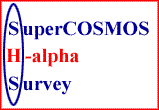
|
|
|
|
|
|
|
|
|
|
|
|
|
|
|
|
|
|
|
|
| |
 | |
| IFA ROE |
Introduction to extracting object catalogues from the SHS
Note: a more detailed guide to using to the catalogue extraction form is given here.
General Warning
Unlike the more general broad-band SuperCOSMOS Sky Surveys (SSS), narrow band H-alpha survey exposures in the SHS often have large areas of emission nebulosity present. These may be intense, diffuse or filamentary in nature. Any IAM data returned in such regions will be of little value. The SuperCOSMOS Image anlyser breaks down such extensive features into meaningless sub-images, often with image parameters characteristic of galaxies. The matching SR data will obviously be much less affected.However, there remain large areas of dense star fields in many Galactic Plane survey exposures which have little or no nebulosity. IAM data will be valid in such regions and such data could be an extremely useful tool for discovering H-alpha emitting point sources, performing statistical analyses etc. In general it would be wise to examine blocked down pixel maps of the regions of interest before extensive analysis of IAM data is undertaken.
Extracting IAM Catalogue data
As for pixel image extraction, selection of object catalogues can be made by both equatorial (RA/DEC) and Galactic (l,b) co-ordinates.There are four basic input parameters to set-up for catalogue extraction from the SHS:
- An input position in Equatorial or Galactic co-ordinates
Entered as free format Right Ascension (RA) & Declination (DEC), e.g. 07 54 55.0 -34 44 13, with equinox (B1950 or J2000), or galactic l,b co-ordinates in decimal degrees, e.g. 250.5709 -3.4301. - A size of region to extract centred on the input position
Area dimension in X and Y from which to extract detected object parameters (in arcminutes). If Y=0 then a circular extraction is performed with radius=X - The survey wave-band Currently either H-alpha or matching SR
- Detected object magnitude range
Entering 0 (bright limit) and 25.0 (faint limit) will return all objects detected down to the exposure limits.
At the moment only the matching H-alpha and contemporaneous SR wavebands are available from the new AAO/UKST Galactic Plane survey (taken on Tech-Pan films on 4-degree field centres). In due course the earlier I/SR surveys of the Galactic Plane taken between 1978 & 1985 will also be incorporated (these were taken on standard 5-degree field centres on IV-N and IIIaF plates) which will enable valuable colour information and proper motions to be provided.
The object parameters returned are derived from the measurement in the primary waveband selected on the form (ie. either H-alpha or SR) but with entries for paramerters in the other waveband(s) where available. The catalogue object parameters returned are the same as those which accommpany the image pixel data extracted with Get an Image in the fits table extensions and are given here
To facilitate a smooth upgrade path placeholders for various IAM parameters for the first epoch SR and I band data are incorporated into the default IAM catalogue listings attached to any pixel map extracted (with Null entries) until the older data is matched in.
The extraction software works across survey field boundaries and therefore large areas can be searched up to several hundred square degrees. The maximum region possible would include a central field and the overlaps North, South, East and West. Due to the high stellar number density in many Galactic Plane fields and the larger number of IAM parameters available for the SHS IAM data, the total size of such an extracted IAM catalogue could be several hundred Mbytes. So although there is no current limit on the size for a catalogue one should consider the practical limitation on access/extraction speed when downloading IAM data.
The user can specify the output equinox, the output epoch and the format (ASCII, Tab, FITS) of the data returned. The tab-separated listing is compatible with the GAIA and CURSA software packages and is useful if you want to overlay the extracted objects on, for example, a radio pixel map (assuming the pixel data comes with a built in World Coordinate System).
Expert parameters are also available on the form. The default values will provide the user with a sensible catalogue that contains a minimum amount of spurious sources (for example areas around bright stars are excluded to prevent contamination from diffraction spikes and haloes).
For the form to successfully return data covering the entire region requested the relevant Galactic Plane survey exposure(s) must have been measured and put on-line. Some films have not yet be taken and/or scanned. A summary of scans currently available on-line can be found under sky coverage.
Home | Intro | Get an Image | Get a Catalogue
Coverage | Documentation | History | Links
WFAU, Institute for Astronomy,
Royal Observatory, Blackford Hill
Edinburgh, EH9 3HJ, UK
M.Read@roe.ac.uk
30/7/2008